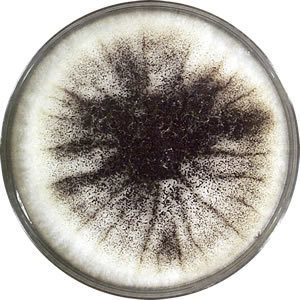Sabouraud Dextrose Agar (SDA): Principle, composition, uses and colony morphology

Sabouraud Dextrose Agar (SDA) is a selective medium primarily used for the isolation of dermatophytes, other fungi and yeasts but can also grow filamentous bacteria such as Nocardia. The acidic pH of this medium (pH about 5.0) inhibits the growth of bacteria but permits the growth of yeasts and most filamentous fungi. Antibacterial agents can also be added to augment the antibacterial effect.
This medium is also employed to determine mycological evaluation of food, contamination in cosmetics and clinically to aid in the diagnosis of yeast and fungal infections.

Antibiotics like chloramphenicol, gentamicin, and tetracycline can be added as selective agents to inhibit bacterial overgrowth of competing microorganisms while permitting the successful isolation of fungi and yeasts. Various other modifications are also reported by using cycloheximide, penicillin, streptomycin, neomycin depending upon the intended use.
Principle :
The SDA media is comprised of enzymatic digest of casein and animal tissues which provide a nutritious source of amino acids and nitrogenous compounds for the growth of fungi and yeasts.
Dextrose is the fermentable carbohydrate incorporated in high concentration as a carbon and energy source. Agar is the solidifying agent. Addition of antibiotics like Chloramphenicol and/or tetracycline acts as broad spectrum antimicrobials to inhibit the growth of a wide range of gram-positive and gram-negative bacteria. Gentamicin is added to further inhibit the growth of gram-negative bacteria.
Composition of media:
| Ingredients | Gm/L |
| Mycological peptone (enzymatic digest of casein and animal tissues) | 10 gm |
| Dextrose | 40 gm |
| Agar | 15 gm |
| pH adjust to 5.6 at 250 C | |
Procedure for preparation of media:
- Suspend 65 g of the medium in one liter of purified water.
- Heat with frequent agitation and boil for one minute to completely dissolve the medium.
- Autoclave at 121° C for 15 minutes.
- Cool to 45 to 50°C and pour into petri dishes or tubes for slants.
- For processing of specimen, streak the specimen onto the medium with a sterile inoculating loop in order to obtain isolated colonies.
- Incubate the plates at 25 – 30°C in an inverted position (agar side up) with increased humidity.
- Cultures should be examined at least weekly for fungal growth and should be held for 4 – 6 weeks before being reported as negative.
Result and interpretation:
After sufficient incubation, the plates should show isolated colonies in streaked areas and confluent growth in areas of heavy inoculation. Examine plates for fungal colonies exhibiting typical color and morphology. Additional procedures should be performed to confirm findings.
Yeasts will grow as creamy to white colonies. Molds will grow as filamentous colonies of various colors.
Typical Colony morphology of some fungi in SDA:
| Fungi | Colony morphology |
| Aspergillus flavus | Yellow-green, powdery and pale yellowish on reverse |
| Aspergillus niger | The initial growth is white, becoming black later on giving “salt and pepper appearance” which results from darkly pigmented conidia borne in large numbers on conidiophores and reverse turning pale yellow |
| Rhodotorula species | pinkish-orangish creamy colonies |
| Aspergillus fumigatus | Blue – green, powdery and pale yellow on reverse . |
| Aspergillus nidulans | Greenish-blue with whitish edge , yellow to brownish on reverse |
| Trichosporon mucoides | White to cream, yellowish, wrinkled |
| Geotrichum candidum | White to cream colored, flat with aerial mycelium |
Limitations :
- It does not promote conidiation of filamentous fungi.
- Antimicrobial agents added into a medium to inhibit bacteria may also inhibit certain pathogenic fungi.
- Avoid overheating a medium with an acidic pH; this may result in a soft medium.